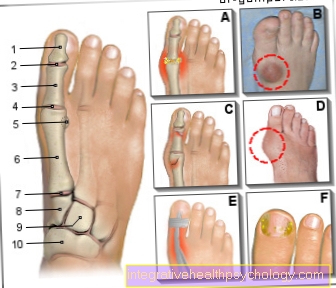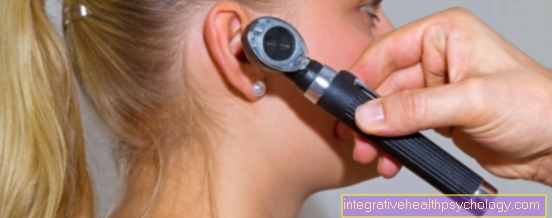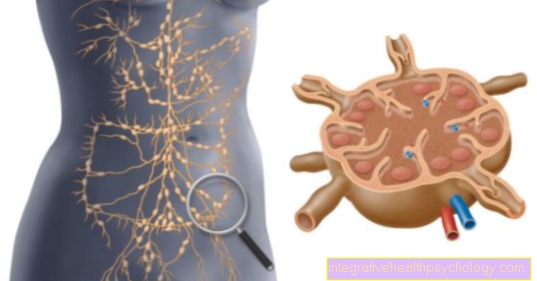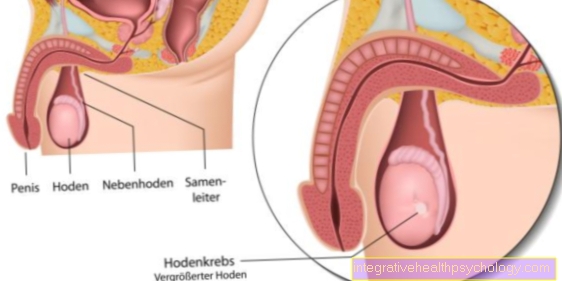How dangerous is the norovirus?
introduction
Along with the rotaviruses, the norovirus is one of the most important pathogens causing diarrhea that cannot be traced back to bacteria. The norovirus belongs to the so-called caliciviruses and is derived from the norwalk viruses named after their location of discovery.
There are many types of noroviruses that can cause infections in cattle, pigs and mice as well as humans. The gastrointestinal flu, which is so typical for humans, is triggered by the human norovirus, which only affects humans. Noroviruses are widespread worldwide and are considered to be very resistant to the environment. For example, they can withstand temperature fluctuations between -20 ° C and + 60 ° C without any problems.
In tests they have shown a survival time of twelve days on infested surfaces (door handles, carpets, fittings ...) and also survive a few days on raw food and in contaminated water.

Structure of the norovirus
Like all viruses, the norovirus does not have its own metabolism and is therefore dependent on other cells to survive and multiply. To do this, it attacks cells in the intestinal mucosa, which are referred to as host cells after they have been infected.
The norovirus is about 35-39 nm thick (i.e. 35 millionths of a millimeter) and has a twenty-surface envelope. Inside it consists only of proteins and the genetic information in the form of an RNA, which it needs to multiply. The RNA is then later introduced into the host cell's RNA, whereupon the infected cell produces proteins for the virus.
New viruses are finally formed from the proteins and RNA that have been produced and, once they have been released, attack other cells. A cycle with massively multiplying viruses and dying host cells is set in motion.
Transmission of the norovirus
The norovirus is extremely easy to transmit between people compared to other viruses. Only 10 to 100 virus particles are enough to fall ill, which is why waves of disease often spread within a few days. An infection is when the virus enters the body and multiplies.
This does not necessarily require direct contact with an infected person, because infection is also possible via a so-called smear infection. For example, touching contaminated objects (e.g. door handles) and food can be enough for a transfer. The virus can survive on objects and surfaces for several days and is even resistant to some disinfectants.
The infection often takes place through the ingestion of the virus through the mouth or nose. One speaks of a fecal-oral transmission. This can happen, for example, if you do not wash your hands thoroughly and eat something after using the toilet.
The viruses are not only spread during the acute illness, but can still be detected for up to 14 days after the end of the illness. Hygiene in dealing with those affected is therefore still an important component in the period after the infection in order to avoid further infection.
Once the virus has been ingested, typical vomiting diarrhea occurs within 10 hours to two days. During this time, the intestinal cells are attacked and, after sufficient damage and self-reproduction, the typical signs of infection with the norovirus appear:
- nausea
- Vomit
- diarrhea
These are defense methods of our body through which it wants to get the pest out of the body as quickly as possible before it continues to attack intestinal cells.
Read more about the topic here: How is the norovirus transmitted?
Sexual transmission
Norovirus infection occurs from person to person and in most cases faecal-oral. Intensive body contact and droplet infection, such as when kissing and exchanging body fluids sexually, increases the likelihood of contracting the norovirus. The norovirus can therefore also be transmitted sexually.
That is how long there is a risk of infection
The norovirus is a highly contagious gastrointestinal virus. Affected persons are already infectious to other people during the incubation period. The risk of infection lasts for several days to two weeks. This means that infected people are still contagious after their symptoms have subsided.
To infect others, 10 to 100 virus particles are enough. Infected people rarely remain permanent. This means that they excrete noroviruses with every bowel movement for months or years and can be contagious.
You might also be interested in: Gastrointestinal Virus - Causes and Treatment
Symptoms of Norovirus Infection
The symptoms of an infection and illness caused by a norovirus have long been known as what is known as vomiting diarrhea. The disease begins a few hours to days after ingestion of the virus, initially with slight nausea, which changes to violent gushing vomiting within a very short time and is accompanied by diarrhea and abdominal pain.
Those affected suddenly feel very sick and may also suffer from a fever and headache. The symptoms themselves are not life-threatening; the person affected can only become maximally dehydrated as a result of the loss of water, caused by vomiting and diarrhea. In the most extreme case, the person affected must be given the essential fluid by infusion in the hospital, if their own drinking is sufficient.
Dehydration is preceded by dizziness and a general weakness. Children and the elderly are particularly at risk here, as their fluid balance is less flexible and fluid deficiencies cannot be compensated so easily by the circulatory system.
After 1-2 days, the symptoms usually disappear on their own in otherwise healthy people without the need for therapy or even hospitalization. Complaints such as fatigue, tiredness and a general feeling of illness can last a few days longer.
Find out more about the topic here: Symptoms of a norovirus infection.
Norovirus infection without vomiting
Norovirus infection typically occurs in adults with diarrhea and vomiting. In rare cases, only vomiting or just diarrhea can occur. There is norovirus infection in adults without vomiting. Infection with noroviruses without vomiting is just as possible in children.
Course of disease
In most cases, infection with noroviruses begins suddenly with severe diarrhea and vomiting. The gastrointestinal complaints can last three to five days. If the disease progresses slightly, these symptoms will improve on their own after 12 to 24 hours.
Severe diarrhea and vomiting carry the risk of significant fluid loss. A severe loss of fluids and electrolytes can cause life-threatening complications such as cardiovascular or kidney failure. Therefore, if the course is severe, hospitalization may be necessary, especially if there are other illnesses and a weakened general condition.
Find out more here: Dehydration - How Do I Know If I Are Dehydrated?
In the course of the disease, further symptoms such as abdominal pain, headache and body aches, a strong feeling of illness and fatigue often occur with a norovirus infection. Body temperature can rise, but fever rarely occurs.
In most cases, the main symptoms will subside after two days.
Duration of illness
The duration of the entire illness is a few days to a week. An infection with noroviruses is usually very rapid and severe.
- The incubation time (the time from infection to onset of the disease) is only a few hours for the noroviruses.
- The possible infection period lasts for several days, even if the symptoms have already subsided in those affected.
- The acute illness with diarrhea and severe vomiting often lasts three to five days.
If the general condition of the infected person is poor, the disease can last significantly longer overall.
Find out more at: Duration of norovirus disease
Is Norovirus Infection Dangerous?
Vomiting diarrhea caused by a norovirus is a self-limiting illness that normally only lasts a few days. Especially in older people or children, the loss of fluids and dissolved electrolytes can lead to complications with circulatory problems or, in the case of an immense lack of fluids, to confusion and a state of orientation.
In principle, the norovirus does not pose a threat to an immunocompetent person.

Diagnosing infection with the norovirus
If sufferers with vomiting diarrhea come to their family doctor, they can make the diagnosis with a high degree of certainty from the survey ask as the timing the occurrence of vomiting diarrhea very much characteristic is. Furthermore, usually not only one affected person comes, because due to the quick and easy spread during the waves of illness, many affected people usually come to the doctor's office within a short time. However, the connection between symptoms and the fact that several people are affected only allows a probable diagnosis; absolute certainty cannot be achieved with it. However, if you want security about the infection with the norovirus, only one can Stool sample Bring certainty. This must be very laborious in a special laboratory to be examined. For this reason, a detailed examination of the stool for noroviruses is only carried out in exceptional cases. In the normal course of the disease, the detection has no direct consequence and does not change the treatment. In addition, the result would only come when the disease has already been overcome. However, should the diarrhea persist for much longer or the fever persist, an exact determination of the pathogen should take place after 2 weeks at the latest.
Is there a test for norovirus infection?
People with a norovirus infection excrete viruses in their stool. Accordingly, the viruses can be detected with a stool test.
There is both an enzyme immune test (EIA) and a nucleic acid test (PCR) to test the stool for noroviruses. The PCR is a particularly sensitive test for the detection of a norovirus infection. This means that people who are actually ill have a high probability of being noticed in the test.
The stool sample also offers the opportunity to quantify the viral load. This provides doctors with information about the infection and its infectivity.
Therapy of an infection with the norovirus
During the illness of one to two days, those affected should take it easy and avoid contact with other people. It is also important to drink as much as possible to prevent dehydration. If necessary, the salts that are important for the body can also be added to the drink or a ready-made solution with all the essential salts can be bought in the pharmacy. However, the correct preparation can easily be researched on the Internet.
Since the norovirus is massively excreted in the stool during this time, you should, if possible, use your own toilet for the duration of the illness and always remove remnants of stool or vomit directly. When removing, rubber gloves should be worn to keep your hands clean.
Regular hand washing and ventilation of the room prevent the risk of infection. It is also strongly advised to change clothes, bed linen, towels and all other hygiene items through which the norovirus could spread. Do not share the hygiene items such as brushes, toothbrushes, towels, etc. in the family environment, but use the items alone.
When washing laundry, boil laundry is essential, because due to their extreme resistance, noroviruses can easily withstand normal 60! C laundry.
In order not to transmit the noroviruses via contaminated food, cooking should be left to others during the infectious period. If those affected have regular contact with children, the elderly and people in nursing homes and hospitals, it is important to avoid these people during the time of the illness.
Overall, it is important to sit out the disease, because there are no causal drugs or treatment options. Antibiotics have no effect on viruses and drugs against nausea and vomiting have so far only been insufficiently researched with regard to their effectiveness.
You can find more information on the topic here: How is norovirus infection treated?
homeopathy
There are homeopathic remedies that can be used for supportive treatment of a norovirus infection. If the symptoms persist after three to four days without any change, a doctor must be consulted.
There are various globules that have a positive effect on the water balance in gastrointestinal diseases and are supposed to promote the regeneration of the intestinal flora. Examples are the globules Borax, Camphora, Chelidonium and Colchicum. There are also Schüssler salts, which are supposed to help with diarrhea and vomiting. These include the Schüssler Salt No. 8, Sodium Chloratum and the Salt No. 10, Sodium Sulfuricum.
Home remedies
There are several home remedies that can help with gastrointestinal problems. Fennel tea, chamomile tea or a combination of fennel, anise and caraway tea help against nausea. Tea provides fluid to the body and the ingredients soothe the stomach. Ginger tea is also said to help fight nausea. To do this, put a few slices of peeled ginger in a vessel, pour boiling water over them and let the liquid steep. Chicken broth is also a good way to give water and salts back to the body.
Against diarrhea, you can leave an apple in the air and let it brown and then eat it. The active ingredient pectin it contains swells in the intestine and absorbs liquid. Bananas also absorb water and help against diarrhea.
You can also dissolve a teaspoon of healing earth in 250 milliliters of water and drink it throughout the day. This helps against diarrhea and provides the body with fluids.
A tip for a norovirus infection is lemon juice. Lemon juice contains citric acid. Citric acid is said to help, comparable to a disinfectant, to slow down the viruses in the body. It binds the highly contagious noroviruses and prevents them from multiplying. Lemon juice is harmless to the body and can be very well drunk when diluted with water.
Length of sick leave
In the case of a norovirus infection, sick leave is often essential and cannot be prevented. In the case of diarrhea, you can initially stay at home for up to 3 days without a sick leave. However, it is important to report to the employer on the first day of illness that you will not appear.
A sick note must be submitted on the fourth day at the latest. Under certain circumstances, the rules on sick leave (certificate of incapacity for work) in the employment contract may be stipulated differently. If you have your family doctor put you on sick leave, the sick leave usually takes 7 to 10 days. The duration depends on the extent of the discomfort. The sick leave usually lasts longer than the main symptoms, as infected people are still contagious after the symptoms have subsided.
Complications of infection with the norovirus
For healthy adults the infection with the norovirus is unpleasant, but rarely life-threatening. Complications can be due to the massive Water loss by the Vomit and the diarrhea occur. Those contained in food and gastric and intestinal juices go with the water Salts lost, so the Salt balance our body disturbed can be. Those affected suffer from the loss of water weakness through the decreased blood pressure and in the worst case, even one can Faint (med = syncope) occur. Since the circulatory system due to the lack of water in the blood has to do more to support the cycle less fluid to maintain the heart has to work harder. A sick heart threatens to quickly reach the end of its reserves and it threatens Heart attacks or Heart failure. Those affected with diseases of the cardiovascular system should pay particular attention to enough Hydration pay attention during the illness and be admitted to hospital early.
The same goes for smaller ones childrenthat naturally have less fluid in their body and thus quickly reach their limits. In addition to the loss of fluids, the loss of body salts such as potassium, calcium and sodium have extreme consequences for the body. One example is potassium, which is easily absorbed when the concentration in the blood changes life-threatening cardiac arrhythmias can be responsible. Here, too, those affected by the heart are particularly at risk again. In total are in the year 2011 43 fatalities has been reported by diseases with the norovirus.
Prophylaxis of infection with the norovirus
A vaccination against noroviruses is not yet possible. Unlike the rotaviruses, for example, the RNA of the nororviruses changes very easily and new virus mutations can arise. DNA viruses are considered to be more stable in terms of genetic material. To date, 7 subgroups of noroviruses have arisen due to changes in the genetic material and these subgroups can often even be divided into further groups. A vaccination against viruses with constantly changing genetic material is therefore hardly possible.
Ultimately, only adequate personal hygiene can protect against infection. Even those not affected can prevent infection with a high probability by regularly washing their hands with soap and cleaning surfaces such as sinks, handles and floors. Disinfectants or normal soap and water can be used here. It is important to note that not all common disinfectants can reliably kill the norovirus. In addition, a face mask and protective gown can be worn in the rooms in which a person concerned is staying or in their presence. However, despite all the hygiene measures, there is no absolute security.
Is there immunity to the noro virus?
Unfortunately, the norovirus does not lead to relevant immunity after infection. According to the Bavarian State Office for Health and Food Safety, people after a norovirus infection can develop short-term resistance / immunity to noroviruses. This means that those affected could not be infected with the virus again immediately after an infection. This temporary resistance occurs only in rare cases and disappears after a certain time. There is no real immunity to noroviruses.
Why is it not possible to vaccinate against the Noro virus?
You cannot vaccinate people against noroviruses because there is still no vaccine against the highly contagious virus. If you want to protect yourself against norovirus infection, you should ensure thorough hand hygiene. Careful hand washing after using the toilet is an important protection measure. Seafood should be cooked through before consumption, and salads should be washed off thoroughly.
Noro virus in babies
Babies, like children and adults, can become infected with noroviruses. The first signs of a norovirus infection in a baby are restlessness, tearfulness and poor drinking. Most often the babies suffer from vomiting and / or diarrhea. Babies can get sore quickly, which is why frequent diaper changes and skin care on the buttocks are very important.
Gastrointestinal disease caused by noroviruses can cause babies to become dehydrated through persistent diarrhea and vomiting. The alarm signs are dry lips, tongue and oral mucosa. With massive fluid loss, the baby's abdominal wall collapses and the skin loses tension. The eyes and the fontanel sink in. Babies become dull, pale, and apathetic. Loss of water is life threatening for babies. If noroviruses are suspected, a baby must be presented to a doctor immediately.
Read more on the subject at: Norovirus infection in the baby
Noro virus in pregnancy
If pregnant women become infected with noroviruses, this often harbors fears for the expectant mother. Noroviruses are basically safe for unborn babies. However, pregnant women must follow important precautions. Close medical monitoring is important if norovirus infection is suspected during pregnancy. In an advanced pregnancy, severe diarrhea can even trigger labor.
In addition to a close medical check-up, measures to be taken during pregnancy include the intake of sufficient fluids. The expectant mother has to make up for water lost through diarrhea and vomiting by drinking at least three liters of water a day.
For more information, see: Norovirus infection in pregnancy
Notification according to the Infection Protection Act
The proven infection with a norovirus is in Germany according to the Infection Protection Act notifiable and always has to be local Health department be communicated. Children with noroviruses are not allowed to go to schools, kindergartens or others for the duration of the illness visit public institutions. Employees who deal with food are only allowed to go back to work two days after the symptoms have subsided. In case of doubt, you should always consult the responsible health department whether an isolation at home necessary is.
Waves of disease
Again and again occur in Germany so-called Disease waves with many frequent cases of the disease. In Central Europe it is mostly the months March and November those with the most frequent cases of illness. In summer to step barely Cases of illness caused by nororviruses. Infection-related gastrointestinal flu are in the Summer months rather on bacteria traced back. If you have been infected in one season, you can only get sick again with the next wave of disease, when a new generation Viruses is responsible for the disease. You can then no longer get sick from the current generation of viruses. The largest waves of illness, the epidemics, have so far mostly been in Hospitals or Care facilities, but also in Kindergartens and others Care facilities observed. In such facilities, the virus benefits from its extreme environmental resilience and easy transmission so that it can easily spread among the many people here. For this reason, entire cruise ships have often been affected by a wave of infections with the norovirus. In 2013, a total of almost 90,000 cases of infection and Diseases caused by the norovirus reported.






.jpg)



















.jpg)


